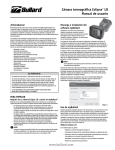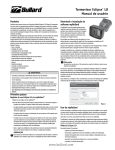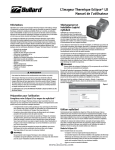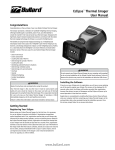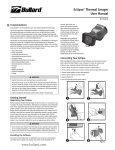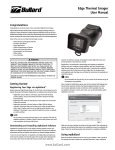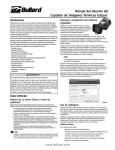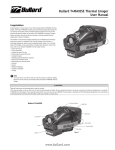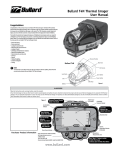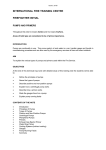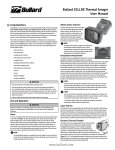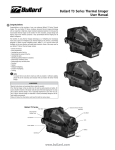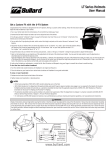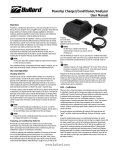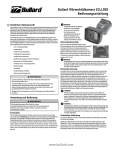Download www.bullard.com Eclipse® LD Thermal Imager User Manual
Transcript
Eclipse® LD Thermal Imager User Manual Congratulations Congratulations on the purchase of your new Bullard Eclipse LD Thermal Imager. The Eclipse LD represents a milestone in handheld firefighting thermal imaging, combining market-leading portability, ease-of-use, and affordability. Designed with high-heat, impact-resistant engineered polymers and infused with the latest thermal imaging technology, the Eclipse LD is a powerful firefighting tool. The benefits of using thermal imaging technology as a firefighting tool encompass nearly every aspect of a firefighter’s job. Thermal imaging is not, however, a technology designed to replace current firefighting tactics. Rather, it is a tool that allows the firefighter to be more effective and make better decisions. Some of the many uses for your Bullard Eclipse LD Thermal Imager include: • Search and rescue • Scene assessment • Locating the seat of the fire • Determining the spread of the fire • Locating hot spots • Identifying potential flashover situations • Determining ventilation points • Determining entry and exit points • Overhaul • Hazmat • Wildland firefighting • Incident investigation • Training Downloading and Installing myBullard Software myBullard is a powerful tool for you to register, inventory, maintain, service, and enhance your thermal imaging products and accessories. This easy-to-use software enhancement will help you organize and optimize your thermal imaging operations. If you turn on your Eclipse LD prior to registration, the Eclipse LD display will advise you of the need to register your thermal imager. This message will be displayed for 30 seconds, after which, the Eclipse LD will function normally. Upon registration; however, the advisory message will disappear and the Eclipse LD will power up to normal operation in less than four seconds. Registration is accomplished by downloading and installing the myBullard software onto your computer, running myBullard, and then connecting your Eclipse LD Thermal Imager via the enclosed data cable. To download the myBullard software, insert the CD that came with your Eclipse LD. After the program loads, click myBullard under the Eclipse LD icon and follow the instructions to download and install the program. NOTE As an alternative to using the CD, you can connect to the internet and go to www. bullard.com/mybullard. � WARNING Read all instructions and warnings before using this product. Your thermal imager is like any other tool. It must be used properly and safely. All users should be trained on the proper and safe use of thermal imaging prior to using the Eclipse LD Thermal Imager. This is especially important for users who may use the Eclipse LD Thermal Imager in hazardous or IDLH (immediately dangerous to life and health) environments. Upon running the installation program, you will be prompted with language and license terms selections and then the following dialog box (Figure 1). Make sure to select applicable modules so that these will be available when you run myBullard. However, if you do not do this, you can still add modules within myBullard at any time. After selecting the modules and clicking the Next button, the installation process for myBullard will begin. Follow the remaining prompts and instructions to complete installation. FAILURE TO FOLLOW THIS INFORMATION COULD RESULT IN DEATH OR SERIOUS INJURY. Getting Started Registering Your Eclipse LD via myBullard™ Before using your Eclipse LD Thermal Imager for the first time, it is necessary for you to register the product with Bullard. Registration accomplishes several important tasks. •Registration assures that you will always stay informed of the latest product updates, service and training information related to the Eclipse LD Thermal Imager. •Registration will reduce the startup time of your imager from 30 seconds to less than four seconds. •Registration activates a security feature on the Eclipse LD. With this feature activated, should your Eclipse LD ever become lost or stolen, provide Bullard with a copy of a police report so we can flag that serial number in our database. If the imager is ever returned to Bullard for service or upgrade, you will be notified. •Upon registration via myBullard, you will be able to download optional features straight to your Eclipse LD Thermal Imager without returning the unit to Bullard. NOTE Do not connect your Eclipse LD Thermal Imager to your computer until after the myBullard software is installed. Failure to observe this practice may result in the installation of defective USB drivers. Figure 1 Using myBullard Begin by launching myBullard from the icon on your desktop. Create a profile in the opening menu and complete the requested information. Upon completion, you will need to activate your account from your email (myBullard will send you an activation email). Once you activate your account, you will be able to use all features in myBullard. myBullard is composed of separate modules, logically categorized to help you navigate within the program. Each module also contains a help section to assist you in using the module. Below are overviews of the modules used with Eclipse LD. Eclipse LD module In the Eclipse LD module, you can: • register your Eclipse LD thermal imager(s) • customize the look of installed features and startup graphics • inquire about and download features additions and upgrades to your Eclipse LD thermal imager(s) • manage your Eclipse LD inventory and installed features • review operating manuals www.bullard.com Use and Operation SceneCatcher module (optional) If your Eclipse LD is equipped with the SceneCatcher Digital Video Recorder, make sure you have installed the SceneCatcher module (instructions for installing a module are below). In the SceneCatcher module, you can: • manage recorded videos on your Eclipse LD or on your PC • play back, move, and delete video clips you have recorded with SceneCatcher • capture a screen shot • view, move, and delete captured screen shots • synchronize Eclipse LD internal clock with PC • access manuals Power To turn on your Bullard Eclipse LD Thermal Imager, depress the black power button located on top of the unit (Figure 3). Upon pressing the power button, you will hear Figure 3 an audible click, and the thermal imager will display the Bullard logo. A thermal image will appear within a few seconds. This image consists of black, white and gray elements indicating heat signatures of objects and scene dynamics. Warmer elements appear as lighter shades, while cooler elements appear as darker shades. To turn off power, depress the power button. NOTE Battery Status Indicator For instructions on how to use other modules that are available via myBullard, consult the corresponding user manuals of these products located in the modules. A battery status indicator, located at the bottom center of the display, indicates the remaining battery charge for the Eclipse LD. A full charge is indicated by a full green bar in the battery indicator. During operation, the bar will deplete from left to right, changing to yellow when it reaches 50% charge, and then to red when it reaches 25% charge. At 10% remaining charge, the red bar will flash. Installing a module To install a module in myBullard, click the “+” symbol located in the bottom right corner of the myBullard main screen. Click the “Available Modules” tab and select a new module from the list. Connecting Your Eclipse LD After installing the myBullard software, you will need to connect your Eclipse LD Thermal Imager to your computer. In order to connect your Eclipse LD to your computer, please follow these steps (Figure 2): 1. Press in firmly and pull back on battery release to release battery. 2. Press in firmly and pull back on battery release and insert red data cable assembly. 3. Connect power adaptor to red data cable assembly. 4. Connect power adaptor to power outlet. 5. Connect USB to PC. 6. Turn on Eclipse LD by pressing power button. NOTE Y ou will periodically observe a momentary freeze in the image. This is normal and is a function of the self calibration shutter. The shutter will activate every 30 seconds to three minutes, depending on the environment. Temperature Measurement Features Your Eclipse LD may be equipped with an optional temperature measurement feature. If equipped, the default setting for your Eclipse LD shows a numeric temperature indicator on the top right portion of the display. The number displayed represents the approximate temperature of the object viewed within the “crosshairs” shown in the middle of the display. With myBullard, you can also select your Eclipse LD to display the Relative Heat Indicator (RHI) feature. If activated, the right portion of the display on the Eclipse LD will show a bar graph style temperature gauge. The RHI functions identically to the numeric temperature display except that the temperature is displayed graphically as a bar. The accuracy of the indicators is dependent on numerous factors including the distance from the object being viewed and its emissivity, which is the object’s ability to radiate heat. Units are calibrated with a preset emissivity corresponding with normal construction materials. Objects with emissivities that vary greatly from this, such as metals and shiny objects, will reduce the accuracy of the temperature indication. Additionally, temperature measurement accuracy decreases as the distance from the object in the “crosshairs” increases. NOTE The RHI and numeric temperature indicators provide a quick reference to compare objects of similar emissivities to serve as a guide to pinpoint intense heat sources. Due to the inherent issues with accuracy, use these features with caution and verify indicated heat levels through traditional means whenever possible. NOTE Figure 2 NOTE Ensure you use the red data cable assembly. Previous Eclipse versions with black assemblies are not compatible with Eclipse LD. 2 You can customize how temperature measurement is displayed on your Eclipse LD. With myBullard, you can select either the RHI or numeric indicators or both to display on the Eclipse LD and choose either Fahrenheit or Celsius scales. To change the default setting, go to myBullard and locate the Temperature Measurement settings within the Eclipse program menu. Super Red Hot Your Eclipse LD may be equipped with Bullard’s Super Red Hot feature which colorizes heat levels in various color hues. Starting at 500 F degrees, heated objects are tinted yellow and gradually transition to orange and then to solid red as heat levels rise. This feature identifies specific heat layers alerting firefighters to areas of intense heat providing an enhanced visual awareness of the hottest objects in a scene. www.bullard.com Eclipse® LD Thermal Imager User Manual Electronic Thermal Throttle® NOTE Your Eclipse LD may be equipped with Electronic Thermal Throttle (ETT), a highly useful and unique feature available on Bullard firefighting Thermal Imagers. The ETT is ideal for pinpointing hot spots during overhaul, searching for overheated electrical equipment, or clarifying objects in ambient temperature situations. To activate the ETT option, locate the rubber cover on the top of the Eclipse LD. Press Figure 4 the left side of the cover, which is the left button on the throttle, to activate the ETT (Figure 4). The ETT will automatically sense the hottest area in the scene and color it blue. Additional presses of the left button will further engage ETT and will color more of the scene blue, eventually coloring even the coolest objects blue. NOTE As the throttle engages more of the scene, the blue will become lighter in hue to help differentiate objects in the scene. As you cycle through the scene, you’ll see the symbol “TT” and a corresponding number in the upper left hand corner of the display. The “TT” indicates “Thermal Throttle” mode. The number (0-99) is a point of reference to indicate the level of Thermal Throttle engagement; by itself it has no specific meaning. Most of the benefits of the ETT are accomplished with the first few presses of the button. To deactivate the ETT or lessen the amount of blue in the scene, press the right side of the cover, which is the right button on the throttle. Alternatively, you can quickly deactivate the ETT, by pressing both buttons simultaneously for one second or turning off the Eclipse LD and turning it back on. If the battery is inserted without first retracting the battery release switch, the battery will not fully seat. If this occurs, remove the battery and follow reload using the instructions above. The battery latch mechanism prevents accidental battery release upon impact. Charging and Maintaining Batteries If you purchased an Eclipse LD Powerhouse with your Eclipse LD Thermal Imager, see the enclosed Powerhouse manual for charging instructions. If you purchased an Eclipse LD Thermal Imager only, you received a charging base. Figure 6 To charge a battery in the charger included with your Eclipse LD, place it in the charging base (Figure 6). A steady red light will indicate that the battery is charging, while a steady green light will indicate a full charge. The system will detect the full charge and will not overcharge the battery. A completely drained battery takes up to three hours to fully recharge. As with all batteries, your Bullard rechargeable battery will experience a slow drain of its charge during storage. The amount of drain varies widely based on storage conditions. To ensure adequate battery life, charge each of your batteries every two weeks or, for best performance, keep your Eclipse LD and spare battery charged in your vehicle in the Eclipse LD Powerhouse truck mount charger accessory (part number: ECLPOWERHOUSE). If you are using a Powerhouse charger, follow the instructions contained in the accompanying manual. � WARNING � CAUTION Do not allow the metal contacts on the battery to come in contact with a conductive surface, such as a metal table or another battery. While the Eclipse LD battery is equipped with protective circuitry to prevent product damage, contact with conductive surfaces can complete the battery circuit and cause the battery to overheat or melt. Failure to observe this warning may result in permanent battery damage, property damage and/or serious injury. The Eclipse LD Thermal Imager is extremely sensitive to intense, radiant heat sources. Never point the Eclipse LD at the sun or any other source of extreme radiant heat, as this could severely damage the thermal imager. Custom Startup Graphic Via myBullard, you can customize the startup graphic which appears when you first power on your Eclipse LD. To upload your own image and change the startup graphic on your Eclipse LD, go to myBullard and select the Eclipse LD module. You will see a selection for customizing the startup graphic. Follow the instructions in myBullard to upload a new graphic and change it on your Eclipse LD. SceneCatcher Digital Video Recorder NOTE New, fully charged NiMH batteries will provide a run time of more than two hours. To extend the potential lifespan of your batteries, fully drain and recharge each battery monthly. For best operational results, develop a clear formalized plan for maintaining, charging, and replacing your batteries. Your Eclipse LD may be equipped with Bullard’s SceneCatcher digital video recording accessory. For the Eclipse LD, the SceneCatcher is installed inside the thermal imager so there are no external attachments. To activate the SceneCatcher, locate the rubber cover on the top of the Eclipse LD. Press and hold the right side of the cover until the red dot appears in the upper left hand corner of the Eclipse LD display. When the red dot is visible on the display, you are recording video to the unit’s internal memory. To deactivate the SceneCatcher, press and hold the right side of the cover until the red dot disappears. Retractable Strap Loading/Unloading a Battery The Bullard Eclipse LD Thermal Imager requires little maintenance. For best results, after each use: • Clean the outside of the unit with mild soap or detergent. • Wipe the lens with a soft cloth. • Clean the display with a soft cloth. • Check screw tightness on cover display. • Store your thermal imager in the optional truck mount or in the delivery case provided. • All thermal imagers should be maintained using a proper program. To load a battery (Figure 5), depress and then slide the battery release switch in the direction of the arrow indicated on the button. With the battery release switch engaged, slide the battery into the groove in the cavity located at the bottom of the unit. You will hear an audible “click” when the battery is properly seated. To unload a battery, depress and then slide the battery release switch in the direction of the arrow indicated on the switch. With the battery release switch engaged, grip the battery by its exposed bottom section and pull it away from the unit (Figure 5). Figure 5 The Eclipse LD Thermal Imager fits easily into a turnout gear pocket for convenient storage while crawling or working. Additionally, Bullard offers a retractable strap that can be used with the Eclipse LD, so that it is always at the ready. The strap, purchased separately, can be mounted to a D-ring on your turnout gear coat and connected to the D-ring on the Eclipse LD. Care Instructions www.bullard.com 3 Cleaning the Lens The Bullard Eclipse LD lens is recessed in an impact resistant bezel. The lens can be cleaned with a soft cloth and soapy water as required. Replacing the Video Display Cover Window The display cover (Figure 7) has a scratch-resistant hard coating to Figure 7 minimize marring. However, if heavy scratching or gouging does occur, the cover window can be replaced. To do this, remove the four Phillips head screws along the sides of the window. Remove the plastic display cover window and replace with a new one (part number: ECLLDWINDOW). Do not over-tighten. � CAUTION Do not use solvents or paint thinners to clean your Bullard Eclipse LD Thermal Imager, as they could permanently mar the surface or degrade the protective properties of the casing. Do not intentionally submerge the unit underwater or subject the unit to highpressure water. Follow care instructions described above. Failure to observe these instructions may result in product damage. Any damage caused by improper care is not covered under warranty. � WARNING Do not attempt to disassemble the Bullard Eclipse LD Thermal Imager. Disassembling the unit voids all warranties. Only parts that use Phillips head screws are field-serviceable. Like all thermal imagers sold at the time of this printing, the Bullard Eclipse LD is not certified as intrinsically safe. Failure to follow these instructions could result in death, serious injury and/or product damage. Thermal imaging is not a technology designed to replace current firefighting tactics. Rather, it is a tool that allows the firefighter to be more effective and to make better decisions. Firefighters should not stop using basic fire safety tactics. All firefighters should receive proper training on the following topics: how thermal imagers work; the uses and limitations of thermal imagers; image interpretation; and the safety considerations for thermal imaging use. Service If your Bullard Thermal Imager is not performing properly, contact Bullard Customer Service at 877-BULLARD (285-5273). Outside the U.S. and Canada, call 1-859-234-6611. Describe the problem to the Bullard representative as completely as possible. For your convenience, your representative will try to help you diagnose or correct the problem over the phone. Before returning your Bullard Thermal Imager, you should verify with your representative that the product should be returned to Bullard. Bullard Customer Service will provide you with written permission and a return authorization number. If the return is a non-warranty repair, a Bullard Customer Service Representative or your local distributor will provide you with a repair invoice estimate. To authorize repair, you must provide a purchase order to your distributor for the amount of the estimate. Once Bullard or a local distributor authorizes your repair, Bullard will issue you a return authorization number so that you can return the unit to Bullard. Bullard will repair the unit and ship it from our factory within 48 business hours. If the cost of repairs exceeds the stated quote by more than 15% or by more than $100, a Bullard Americas: Bullard 1898 Safety Way Cynthiana, KY 41031-9303 • USA Toll-free within USA: 877-BULLARD (285-5273) Tel: +1-859-234-6616 Fax: +1-859-234-8987 Europe: Bullard GmbH Lilienthalstrasse 12 53424 Remagen • Germany Tel: +49-2642 999980 Fax: +49-2642 9999829 representative will re-estimate your repair and Bullard or your local distributor will contact you for authorization to complete repairs. After repairs are completed and the goods have been returned to you, Bullard or your distributor will invoice you for the actual repair amount. NOTE Prior to returning your Bullard Thermal Imager, decontaminate and clean the thermal imager to remove any hazardous or contaminated materials that may have settled on the product during use. Laws and/or shipping regulations prohibit the shipment of hazardous or contaminated materials. Products suspected of contamination will be professionally decontaminated at the customer’s expense. Returned products will be inspected upon return to the Bullard facility. If the repair is under warranty, Bullard will repair the unit and ship it from our factory within 48 business hours. Warranty Bullard warrants to the original purchaser that the Bullard Eclipse LD and all features/ accessories installed in the unit as well as battery charging units are free of defects in materials and workmanship under intended use and service for a period of one (1) year from date of activation. Bullard’s obligation under this warranty is limited to repairing or replacing, at Bullard’s option, articles that are returned within the warranty period and that, after examination, are shown to Bullard’s satisfaction to be defective, subject to the following limitations: a) Article must be returned to Bullard with shipping charges prepaid. b) Article must not be altered from its original configuration. c) Article must not have been misused, abused, or damaged in transport. d) Maintenance and field replaceable items, if defective, are covered under warranty for a ninety (90) day period from the date of purchase. These items include: •Batteries •Straps • Display covers • AC/DC adapters Bullard provides a limited lifetime warranty on the Eclipse LD outer shell. This warrants that the outer shell is free of defects in materials and workmanship under intended use and service for the original purchaser. Bullard’s obligation under this warranty is limited to repairing or replacing, at Bullard’s option, articles that after examination are shown to Bullard’s satisfaction to be defective, subject to the following limitations: 1. Article must not be altered from its original configuration. 2. Article must not have been misused, abused, or damaged in transport. 3. When the outer shell is obsolete and Bullard no longer stocks the part, the limited lifetime warranty will be terminated. In no event shall Bullard be responsible for damages, loss of use, or other indirect, incidental, consequential or special costs, expenses or damages incurred by the purchaser, notwithstanding that Bullard has been advised of the possibility of such damages. Any implied warranties, including warranties of merchantability and fitness for a particular purpose, are limited in duration to one (1) year from the date of manufacture of this. ISO 9001 certified Asia-Pacific: Bullard Asia Pacific Pte. Ltd. LHK Building 701, Sims Drive, #04-03 Singapore 387383 Tel: +65-6745-0556 Fax: +65-6745-5176 w w w.b u ll a rd. c om ©2015 Bullard. All rights reserved. Eclipse and Electronic Thermal Throttle are registered trademarks of Bullard. myBullard is a trademark of Bullard. 60500010198C (0815)





